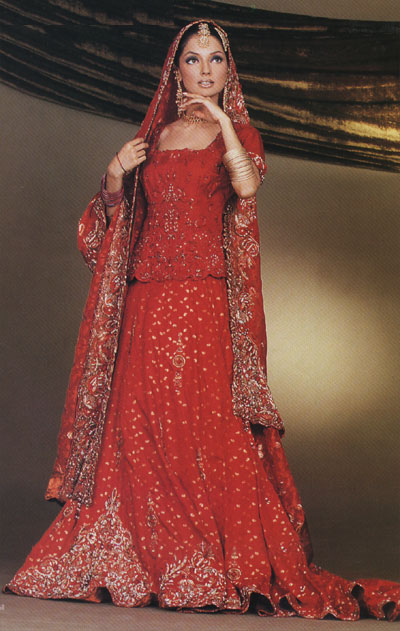pakistani clothes online Biogarphy
source(google.com.pk)Churidars, , or more properly churidar pyjamas, are tightly fitting trousers worn by both men and women in South Asia. In Pakistan Churidar is most famous in people of North Indian Origin including Pakistani Punjabis and in people of Karachi who migrated from India in 1947. Churidars are a variant of the common salwar pants. Salwars are cut wide at the top and narrow at the ankle. Churidars narrow more quickly, so that contours of the leg are revealed. They are usually cut on the bias (at a 45-degree angle to the grain of the fabric) which makes them naturally stretchy. Stretch is important when pants are closefitting. They are also longer than the leg and sometimes finish with a tightly fitting buttoned cuff at the ankle. The excess length falls into folds and appears like a set of bangles resting on the ankle (hence ‘churidar’; ‘churi’: bangle, ‘dar’: like). When the wearer is sitting, the extra material is the “ease” that makes it possible to bend the legs and sit comfortably. The word “churidar” is from Hindi and made its way into English only in the 20th century. Earlier, tight fitting churidar-like pants worn in India were referred to by the British as Moghul breeches, long-drawers, or mosquito drawers.The churidar is usually worn with a kameez (tunic) by women or a kurta (a loose overshirt) by men, or they can form part of a bodice and skirt ensemble, as seen in the illustration of 19th century Indian women wearing churidar with a bodice and a transparent overskirt.Amidst its royal grandeur, enigmatic feel and feminine charm salwar kemeez breathes the sighs of history. With its roots deeply seated in the antiquities of medieval India, the origin of Salwar Kameez still carries the rich sartorial chronicle amidst its fall, stitch, luster and feel.In the hinter lands of Central Asia, which was then under the domination of Iranian and Turkish people; Salwar kameez as an expression of Indian ethnicity made its presence felt for the very first time. The general habit of the Iranian and Turkish people were putting in baggy trousers whilst drawing it tight with strings. Research says that this pattern was indeed the progenitor of today’s salwar kameez. Thus this era actually states the origin of salwar kameez.
The salwar is basically a loose trouser, which narrows down a bit towards the bottom. However the Iranian and Turkish concept of fastening it with string later was largely replaced by the concept of elastic belt. On the other hand the kameez is more like a long shirt or tunic like apparel, which is further adorned by a dupatta.
Not only in Central Asia, origin of salwar kameez unveils the fact that, even the court nobles of the Qajar and Ottoman dynasty preserved salwar kameez as their court attire. However in India the style of salwar kameez was imported as an immediate effect of Muslim invasion, back in the 12th century. The Turko Iranian regime and then followed by the Mughal regime in India established the Iranian fashion of Indian salwar kameez while offering it a typical Mughal overtone. Hence it won’t be an overstatement to say that it was the Mughal Dynasty, which upheld the tradition of royal ethnicity amidst the feminine charm of Indian salwar kameez. The tale of ethnicity, which originated in India with the Mughals later gained a remarkable dimension with the popularity of the attire.
pakistani clothes online Photos Pictures Pics Images

pakistani clothes online Photos Pictures Pics Images

pakistani clothes online Photos Pictures Pics Images

pakistani clothes online Photos Pictures Pics Images

pakistani clothes online Photos Pictures Pics Images

pakistani clothes online Photos Pictures Pics Images

pakistani clothes online Photos Pictures Pics Images

pakistani clothes online Photos Pictures Pics Images

pakistani clothes online Photos Pictures Pics Images
No comments:
Post a Comment